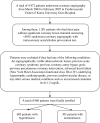Impact of hypertension on coronary artery spasm as assessed with intracoronary acetylcholine provocation test
- PMID: 19458625
- PMCID: PMC3011093
- DOI: 10.1038/jhh.2009.40
Impact of hypertension on coronary artery spasm as assessed with intracoronary acetylcholine provocation test
Abstract
Both hypertension and coronary artery spasm (CAS) are associated with endothelial dysfunction. Thus, a higher incidence of CAS is expected in hypertensive patients. We evaluated the impact of hypertension on CAS with intracoronary acetylcholine (ACh) provocation test. A total of 986 patients (685 hypertensive patients vs 301 normotensive patients) who underwent coronary angiography with ACh provocation test were enrolled. ACh was injected into the left coronary artery in incremental doses of 20, 50 and 100 microg min(-1). Significant CAS was defined as a transient >70% luminal narrowing with concurrent chest pain and/or ST-segment changes. Although the incidences of significant ACh-induced CAS were similar between hypertensive and normotensive patients (35.8 vs 39.2%, P=0.303), multivariate logistic analysis showed that hypertension was negatively associated with ACh-induced CAS (odds ratio: 0.70, 95% confidence interval: 0.51-0.94, P=0.020). The angiographic characteristics of ACh-induced CAS were similar between these two groups. Subgroup analysis regarding the impact of the status of blood pressure control on CAS showed that hypertensive patients with controlled blood pressure had a significantly higher incidence of CAS than those with uncontrolled blood pressure (45.2 vs 27.9%, P<0.001), and that uncontrolled blood pressure was negatively associated with ACh-induced CAS (odds ratio: 0.56, 95% confidence interval: 0.40-0.79, P=0.001). In conclusion, despite the expected endothelial dysfunction, hypertension and uncontrolled blood pressure are negatively associated with CAS, suggesting that the mechanisms and risk factors of CAS may be significantly different from those of coronary artery disease.
Figures



Similar articles
-
Peripheral arterial disease is associated with coronary artery spasm as assessed by an intracoronary acetylcholine provocation test.Clin Exp Pharmacol Physiol. 2009 Nov;36(11):e78-82. doi: 10.1111/j.1440-1681.2009.05273.x. Epub 2009 Aug 4. Clin Exp Pharmacol Physiol. 2009. PMID: 19671066
-
Diabetes mellitus is not a risk factor for coronary artery spasm as assessed by an intracoronary acetylcholine provocation test: angiographic and clinical characteristics of 986 patients.J Invasive Cardiol. 2014 Jun;26(6):234-9. J Invasive Cardiol. 2014. PMID: 24907077
-
Impact of alcohol drinking on acetylcholine-induced coronary artery spasm in Korean populations.Atherosclerosis. 2018 Jan;268:163-169. doi: 10.1016/j.atherosclerosis.2017.11.032. Epub 2017 Dec 8. Atherosclerosis. 2018. PMID: 29227870
-
Overview of the Acetylcholine Spasm Provocation Test.Clin Cardiol. 2015 Jul;38(7):430-8. doi: 10.1002/clc.22403. Epub 2015 Jul 14. Clin Cardiol. 2015. PMID: 26175183 Free PMC article. Review.
-
Role of acetylcholine spasm provocation test as a pathophysiological assessment in nonobstructive coronary artery disease.Cardiovasc Interv Ther. 2021 Jan;36(1):39-51. doi: 10.1007/s12928-020-00720-z. Epub 2020 Oct 27. Cardiovasc Interv Ther. 2021. PMID: 33108592 Free PMC article. Review.
Cited by
-
Epidemiology, Trends, Utilization Disparities, and Outcomes of Catheter Ablation and Its Association With Coronary Vasospasm Amongst Patients With Non-valvular Atrial Fibrillation: A Nationwide Burden of Last Decade.Cureus. 2023 Jun 19;15(6):e40649. doi: 10.7759/cureus.40649. eCollection 2023 Jun. Cureus. 2023. PMID: 37342301 Free PMC article.
-
Significant response to lower acetylcholine dose is associated with worse clinical and angiographic characteristics in patients with vasospastic angina.Korean Circ J. 2013 Jul;43(7):468-73. doi: 10.4070/kcj.2013.43.7.468. Epub 2013 Jul 31. Korean Circ J. 2013. PMID: 23964293 Free PMC article.
-
Effects of statins in patients with coronary artery spasm: A nationwide population-based study.Clin Transl Sci. 2024 Nov;17(11):e70087. doi: 10.1111/cts.70087. Clin Transl Sci. 2024. PMID: 39568301 Free PMC article.
-
Impact of Renin-Angiotensin System Inhibitors on Long-Term Clinical Outcomes of Patients With Coronary Artery Spasm.J Am Heart Assoc. 2016 Jul 21;5(7):e003217. doi: 10.1161/JAHA.116.003217. J Am Heart Assoc. 2016. PMID: 27444508 Free PMC article.
-
Impact of old age on clinical and angiographic characteristics of coronary artery spasm as assessed by acetylcholine provocation test.J Geriatr Cardiol. 2016 Oct;13(10):824-829. doi: 10.11909/j.issn.1671-5411.2016.10.005. J Geriatr Cardiol. 2016. PMID: 27928223 Free PMC article.
References
-
- Psaty BM, Lumley T, Furberg CD, Schellenbaum G, Pahor M, Alderman MH, et al. Health outcomes associated with various antihypertensive therapies used as first-line agents: a network meta-analysis. JAMA. 2003;289:2534–2544. - PubMed
-
- Davignon J, Ganz P. Role of endothelial dysfunction in atherosclerosis. Circulation. 2004;109:III27–III32. - PubMed
-
- Lavi S, Yang EH, Prasad A, Mathew V, Barsness GW, Rihal CS, et al. The interaction between coronary endothelial dysfunction, local oxidative stress, and endogenous nitric oxide in humans. Hypertension. 2008;51:127–133. - PubMed
-
- Kugiyama K, Murohara T, Yasue H, Kimura T, Sakaino N, Ohgushi M, et al. Increased constrictor response to acetylcholine of the isolated coronary arteries from patients with variant angina. Int J Cardiol. 1995;52:223–233. - PubMed
-
- Kugiyama K, Yasue H, Okumura K, Ogawa H, Fujimoto K, Nakao K, et al. Nitric oxide activity is deficient in spasm arteries of patients with coronary spastic angina. Circulation. 1996;94:266–271. - PubMed
MeSH terms
Substances
LinkOut - more resources
Full Text Sources
Medical
Miscellaneous

